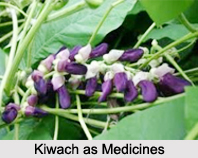 Kiwach has been used since ancient times in Ayurvedic medicine for the treatment of Parkinson"s disease, as well as for treating anxiety, arthritis and parasitic infections. The English names "Cowage" or "Cowitch" are derived from the Hindi "Kiwach". The plant is indigenous to India and has been used in Hindu medicine from a very ancient period. Mucuna Pruriens is the scientific name of Kiwach. It is also used to relieve pain and fever, to induce vomiting and to treat snakebite. Some people apply Kiwach directly to the skin for joint and muscle pain, to stimulate surface blood flow in conditions that involve paralysis and to treat scorpion stings.
Kiwach has been used since ancient times in Ayurvedic medicine for the treatment of Parkinson"s disease, as well as for treating anxiety, arthritis and parasitic infections. The English names "Cowage" or "Cowitch" are derived from the Hindi "Kiwach". The plant is indigenous to India and has been used in Hindu medicine from a very ancient period. Mucuna Pruriens is the scientific name of Kiwach. It is also used to relieve pain and fever, to induce vomiting and to treat snakebite. Some people apply Kiwach directly to the skin for joint and muscle pain, to stimulate surface blood flow in conditions that involve paralysis and to treat scorpion stings.
Dose of Kiwach in Medicine
Sushruta describes the seeds as a powerful aphrodisiac, and gives the following formula for their use. Take the seeds of Mucuna Pruriens and the fruits Tribulus Terrestris (Gokshura) equal parts and administer in doses of about a drachm with sugar and tepid milk.
The Bhavaprakasa recommends the following preparation called "Vanari Vati". Take the seeds of Mucuna Pruriens 32 tolas; boil them in 4 seers of cow"s milk till the latter becomes thick. The seeds should now be decorticated and pounded, then fried in clarified butter and made into a confection with double their weight of sugar. The mass should then be divided into balls which should be steeped in honey. The dose should be about a tola. This preparation is said to be the best of aphrodisiacs.
The root of Mucuna Pruriens is considered tonic and useful in diseases of the nervous system, such as facial paralysis, hemiplegia etc. It is generally used in combination with other medicines of its class, as for example in the compound decoction called "Mashbaladi".
This article is a stub. You can enrich by adding more information to it. Send your Write Up to content@indianetzone.com
Related Articles
Ayurveda
Ayurveda Medication
Elements of Ayurveda
Concepts of Ayurveda
Ancient Literature of Ayurveda




















